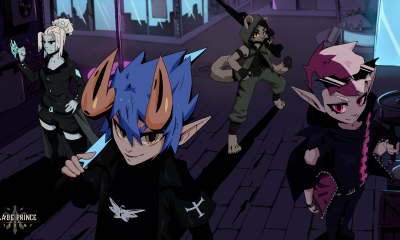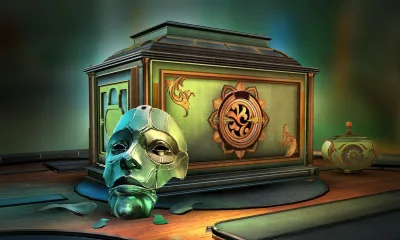Reviews
Revere Review (PC)

Ever since Five Nights at Freddy’s came knocking, countless games have tried to replicate that award-winning formula — so much, that we’ve often found it difficult to distinguish the textbook clones from the source material. For the record, Revere just so happens to fall into one of these categories, as it more or less leans on all the same mechanical elements and theatrics. But I’m not complaining; on the contrary, I’m over the moon, as I’m finally able to sink back into a good pair of shoes—a size that, despite being a little worn down and exempt from longer hikes, still fits snugly around the ankles. That, to me, is Revere: a comfortable pair of shoes that I’d be able to identify in a heartbeat, blissfully aware of their limitations and inability to breach vast new borders. But, like I said — they fit, and I really, really enjoy wearing them.
Of course, Revere isn’t a pair of shoes, but rather, a psychological point-and-click horror game that bases its entire world around two things: a seemingly desolate chapel that’s without a power source, and a looming threat that just so happens to have the keys to your private quarters. In a true Five Nights at Freddy’s fashion, your goal is to survive the nights as they come, and whittle down a series of roadblocks that stand between you and the next encounter with the mysterious figure that wallows in the shadows.
So, is Revere actually worth its price of admission? Or better yet, is it worth sidelining a slew of other FNaF lookalikes for? Let's talk about it.
Bad Things Come in Threes

If you've already taken the opportunity to delve into Scott Cawthon's Five Nights at Freddy's, and, by some random miracle, successfully managed to breeze through the fifth shift, then you're probably armed to the teeth with just the right tools needed to tackle Revere. Why? Well, as it turns out, mechanically, the two aren't all that different, in the case that your two primary objectives mainly consist of either checking corners and camera feeds for nearby threats, and fumbling for small components to solve a few puzzles on the side. Of course, there's a little more to it than that; there's a storyline, too, which, in all honesty, isn't all that present in Five Nights at Freddy's – unless, of course, you happen to brush up on its catalog of lore beforehand, anyway.
It goes like this: you’ve got a series of tapes to work through—episodic sequences that revolve around a dark room, and a treasure trove of intrigue lock combinations and logical puzzles. In a typical point-and-click style, you have the power to manipulate certain items, either by manually changing digits on padlocks, or by adjusting dials and other forms of frequencies. The only issue is, the room that you’re in is dark—pitch black, even, which means you need to use the short amount of time that you have to tiptoe between obstacles, and solve hidden challenges in order to progress, all whilst keeping an ear out for any nearby intruders at one or two doors. Sounds simple enough, right? *laughs in frustration*
Frustratingly Opaque

Arguably one of the most tedious things that I stumbled across in the early phases of the story was the flashlight, or rather, the lack of light that such an item should, in all fairness, project. Weirdly enough, you can take full advantage of the cone of light when peeking out of one of the corridors, but not in the central chamber—a location that houses most, if not all of the puzzles and environmental curveballs. And yes, while you can tweak the graphics to showcase a little more of the details in the room, it doesn’t quite make things any less unforgiving. Simply put, the game is too dark, to the point that you can’t actually make heads or tails of the objectives that you’re supposed to be completing directly in front of you. And that’s, you know, annoying.
Granted, it did take me a good few attempts to figure out what it was I was supposed to be doing. I had a room sprawled out in front of me, sure, but with little to no hand-holding or tutorial sequences, I wasn’t entirely sure whether I should’ve been focusing on the creature in the hallway, or the opaque lighting that was preventing me from progressing any deeper into the web of tapes in my archive. In the end, however, I would up doing what any impatient gamer would: clicking just about every corner of the room until something—anything clicked, or even so much as shed light on the next objective. And while this did work on the occasion, it never quite felt like I was earning my stripes, as I was more or less rooting around in the dark and relying on guesswork and dumb luck.
Found You, Again

There is a saving grace to all of this: the jump scares, of which there are plenty strewn between the margins of the gameplay itself. Again, like FNaF (it’s hard to compare it to anything else at this point, to be fair), the main focal point of the experience is within the ever-changing patterns of the creature that haunts you. In each new session, you have to keep track of the corridors and listen out for any subtle changes in the environment; failure to recognize them will ultimately lead you to an unpleasant outcome, and in turn, a stepping stone that takes you back to the beginning of the tape in question.
Having spent a good few years going toe-to-paw with Fazbear and friends, I sort of knew how to keep the threats at bay, even though I was in an entirely different position and locale. But there was a lot to keep track of, though, which was all the more difficult to understand due to the dim lighting and convoluted nature of the scene at hand. However, like a lot of games of its kind, several attempts and aimless romps through the same old motions eventually led me to discover new ways to progress and knuckle in on any leftover content. It wasn’t easy to reach that point — but it happened, for better or for worse, and I wasn’t sure if I was glad to see the end of it all, or eager to unravel more of its mysteries. A bit of both, perhaps.
In spite of all of this, the game itself did, at least, perform to a “good enough” degree; it was mostly without any technical faults or visual flaws, which is often a sight for sore eyes when it comes to indie horror games, for sure.
Verdict

Revere certainly isn't the first point-and-click game to fess up and touch gloves with Five Nights at Freddy's – and it won't be the last, either. The question is, is it a worthy spiritual successor for the ever-popular franchise, or is it merely a footnote on its legendary prowess? Honestly, I’m torn between the two, because while I can see the value in its core features, it’s also difficult to paint it as anything other than a wannabe lookalike with a lot of the same aesthetics. It doesn’t make an attempt to reinvent the wheel, nor does it bend over backwards to create an antagonist that’s even the slightest bit memorable, but it does, however, conjure a solid ambience that’s both unsettling and disturbing in all the right places. And that’s worth something, surely?
I’m not going to sing its praises for any longer than I have to, because there are countless other clones out there that sport a lot of the same tropes. However, I will say this: if you do have a genuine interest in found footage-type games that lean on fairly cheap jump scares and minimal gameplay mechanics, then there’s a good chance that you’ll find something to enjoy in Revere. It isn’t likely to dethrone Five Nights at Freddy’s anytime soon, but it’s worthy of sharing the same platform, for sure. Is it something that you should go out and buy, no questions asked? No. But if you adore horror — so much that you’re willing to take your slice of cake with a few clumps of raw batter on the side, then you’ll no doubt want to take a bite out of this one, warts and all.
Revere Review (PC)
Not Quite Textbook
Don’t get me wrong, Revere does have a lot of great ideas, but they’re often overshadowed by an unfortunate amount of overused tropes that fall directly from the irreplaceable umbrella that is Five Nights at Freddy’s.











